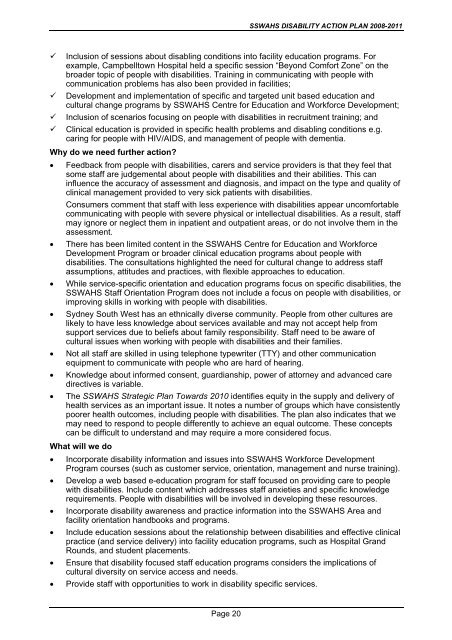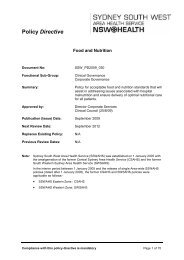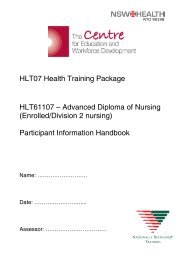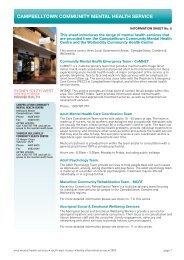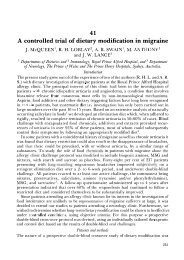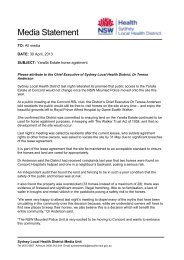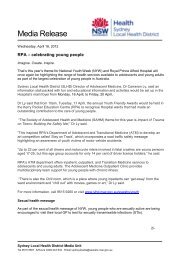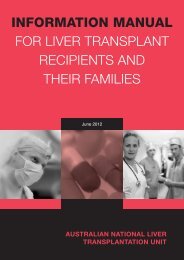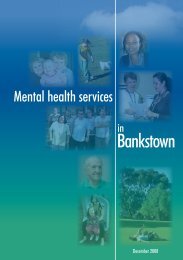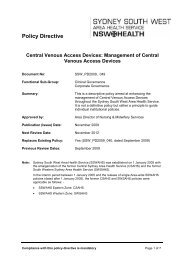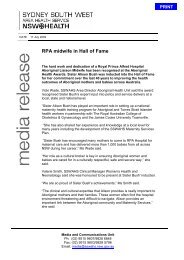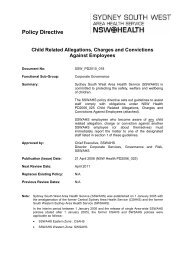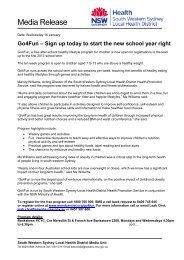SSWAHS Disability Action Plan - Sydney South West Area Health ...
SSWAHS Disability Action Plan - Sydney South West Area Health ...
SSWAHS Disability Action Plan - Sydney South West Area Health ...
Create successful ePaper yourself
Turn your PDF publications into a flip-book with our unique Google optimized e-Paper software.
<strong>SSWAHS</strong> DISABILITY ACTION PLAN 2008-2011 Inclusion of sessions about disabling conditions into facility education programs. Forexample, Campbelltown Hospital held a specific session “Beyond Comfort Zone” on thebroader topic of people with disabilities. Training in communicating with people withcommunication problems has also been provided in facilities; Development and implementation of specific and targeted unit based education andcultural change programs by <strong>SSWAHS</strong> Centre for Education and Workforce Development; Inclusion of scenarios focusing on people with disabilities in recruitment training; and Clinical education is provided in specific health problems and disabling conditions e.g.caring for people with HIV/AIDS, and management of people with dementia.Why do we need further action?• Feedback from people with disabilities, carers and service providers is that they feel thatsome staff are judgemental about people with disabilities and their abilities. This caninfluence the accuracy of assessment and diagnosis, and impact on the type and quality ofclinical management provided to very sick patients with disabilities.Consumers comment that staff with less experience with disabilities appear uncomfortablecommunicating with people with severe physical or intellectual disabilities. As a result, staffmay ignore or neglect them in inpatient and outpatient areas, or do not involve them in theassessment.• There has been limited content in the <strong>SSWAHS</strong> Centre for Education and WorkforceDevelopment Program or broader clinical education programs about people withdisabilities. The consultations highlighted the need for cultural change to address staffassumptions, attitudes and practices, with flexible approaches to education.• While service-specific orientation and education programs focus on specific disabilities, the<strong>SSWAHS</strong> Staff Orientation Program does not include a focus on people with disabilities, orimproving skills in working with people with disabilities.• <strong>Sydney</strong> <strong>South</strong> <strong>West</strong> has an ethnically diverse community. People from other cultures arelikely to have less knowledge about services available and may not accept help fromsupport services due to beliefs about family responsibility. Staff need to be aware ofcultural issues when working with people with disabilities and their families.• Not all staff are skilled in using telephone typewriter (TTY) and other communicationequipment to communicate with people who are hard of hearing.• Knowledge about informed consent, guardianship, power of attorney and advanced caredirectives is variable.• The <strong>SSWAHS</strong> Strategic <strong>Plan</strong> Towards 2010 identifies equity in the supply and delivery ofhealth services as an important issue. It notes a number of groups which have consistentlypoorer health outcomes, including people with disabilities. The plan also indicates that wemay need to respond to people differently to achieve an equal outcome. These conceptscan be difficult to understand and may require a more considered focus.What will we do• Incorporate disability information and issues into <strong>SSWAHS</strong> Workforce DevelopmentProgram courses (such as customer service, orientation, management and nurse training).• Develop a web based e-education program for staff focused on providing care to peoplewith disabilities. Include content which addresses staff anxieties and specific knowledgerequirements. People with disabilities will be involved in developing these resources.• Incorporate disability awareness and practice information into the <strong>SSWAHS</strong> <strong>Area</strong> andfacility orientation handbooks and programs.• Include education sessions about the relationship between disabilities and effective clinicalpractice (and service delivery) into facility education programs, such as Hospital GrandRounds, and student placements.• Ensure that disability focused staff education programs considers the implications ofcultural diversity on service access and needs.• Provide staff with opportunities to work in disability specific services.Page 20


